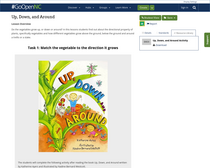Learning Domain: Earth and Environmental Science
Standard: Compare characteristics of objects through observation and action.
Degree of Alignment:
2 Strong
(1 user)
NCES.EX.K.L.2
North Carolina Extended Standards for Science
Kindergarten
Learning Domain: Life Science
Standard: Use observation skills to attend to the environment.
Degree of Alignment:
0 Very Weak
(1 user)
Learning Domain: Life Science
Standard: Describe shared objects and events using attributes (big/small, circle/square, red, green, blue), and location (in, on, out, under, off, beside, behind).
Degree of Alignment:
0 Very Weak
(1 user)
NC.ELA.L.K.6
North Carolina English Language Arts Standards
Kindergarten
Learning Domain: Language
Standard: Use words and phrases learned through conversations, reading and being read to, and responding to texts.
Degree of Alignment:
3 Superior
(1 user)
NC.ELA.L.K.5.a
North Carolina English Language Arts Standards
Kindergarten
Learning Domain: Language
Standard: Sort common objects into categories to gain a sense of the concepts the categories represent.
Degree of Alignment:
2.5 Strong
(2 users)
Learning Domain: Language Standards
Standard: Sort common objects into categories (e.g., shapes, foods) to gain a sense of the concepts the categories represent.
Degree of Alignment:
2 Strong
(1 user)
Learning Domain: Reading Standards for Informational Text
Standard: Actively engage in group reading activities for a clearly stated purpose (e.g., Listen to the story so you can tell me who the main characters are).
Degree of Alignment:
2 Strong
(1 user)



This lesson plan can be applied with Science and Literacy, in the Pre-k to Kindergarten classroom. Their is an open format fro questions and answers about the different vegetables with a KWL Chart to apply what they know and what they would like to learn about this subject.
on Feb 09, 07:43am Evaluation
NCES.EX.K.E.1.2: Strong (2)
The standard for Science E.1.2 is summarize daily weather conditions noting changes that occur from day to day and throughout the year.
on Feb 09, 07:43am Evaluation
Reliability: Very Weak (0)
There is no use of technology.
*As an elementary school media coordinator, I appreciate the potential of this lesson for lower elementary students.
*Full integration of one or more information literacy strategies with subject content.
*Collaboration between SLMC & teachers can be added.
*Strengths: Prior knowledge activated and are used as a catalyst for new knowledge. There are opportunities for real-world applications.
*Opportunities: The SLMC can be an instructional partner in planning and delivering instruction, assessing student progress, and evaluating activities.
I am an elementary media specialist and after viewing this resource it could be remixed for expansion.
Full integration of one or more information literacy strategies with subject content.
Collaboration between SLMC & teachers can be added.
The SLMC could be an instructional partner in planning and delivering instruction, assessing student progress, and evaluating activities.
Information literacy goals could be incorporated seamlessly.
The library could be used as part of the instructional space.
Prior knowledge is activated and used as a catalyst for new knowledge.
There are opportunities for real-world applications.
Digital content could be used in instruction.
Technology could be used for student exploration, organization, and/or creativity.
I can appreciate the incorporation of the book with a hands-on activity for students to get involved after reading and discussing the book.
Partial integration of one or more information literacy strategies by reading the book together.
Collaboration between SLMC & teachers can be added
Strengths: This lessons lends itself to an intersection between art, science, and information literacy skills. Fun!
There's an opportunity for students to draw on their background knowledge and experience with plants and gardens. With lower elementary school students, this could be a lively discussion!
This is a lesson plan for young children that could be tied to science and health.
*Partial integration of one or more information literacy strategies.
*Collaboration between SLMC and teacher could be added.
*Strengths- Lends well to cross curricular activities and fine motor skills
*Opportunities- Tie into a similar book involving foods to do a compare/contrast; real life interactive component where students are given pictures of the foods and group themselves accordingly.
A cute sorting activity for young students. *Partial integration of one or more information literacy strategies by bringing in the SLMC to read to the students, or to read another plant book. I would read Tops and Bottoms by Janet Stevens with this. *Collaboration between SLMC & teachers can be added. *The content could be improved by using an interactive board or projector to have students solve the sorting assignment. I would also like to see some specific questions to use during reading included with the lesson.